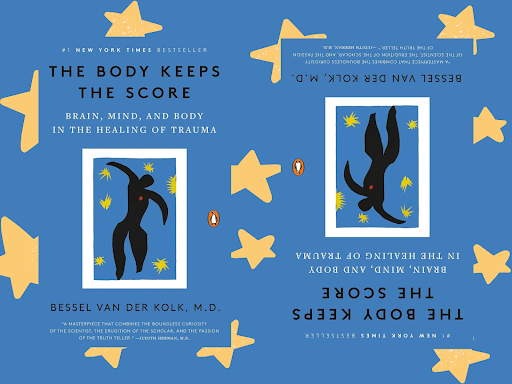The Body Keeps the Score spent 81 weeks at number one on the New York Times bestseller list and is praised by the mental health community as one of the best modern nonfiction books about mental health in this century. Psychologists, doctors, professors, and researchers praise the book for its innovation.
“There is no other volume in the field of traumatic stress that has distilled these domains of science with such rich historical and clinical perspectives, and arrived at such innovative treatment approaches.” wrote Alexander McFarlane AO, MB BS (Hons) MD FRANZCP Director of the Centre for Traumatic Stress Studies; The University of Adelaide, South Australia.
The Body Keeps the Score is a book about mental health, yes– but specifically PTSD, and the sciences, history, research, and first-hand anecdotes the author, Bessel Van Der Kolk, uses to build an understanding of what PTSD is, how it affects his patients, and how to slowly heal.
However as much as The Body Keeps the Score has been praised, this book does have some major flaws. Such borderline victim blaming and desensitization to personal trauma mentioned throughout the book. In a mental health book, the flaws mentioned are major red flags. However, I can look past these flaws to agree with the reviews on a few aspects.
To be able to accurately give, The Body Keeps the Score, an analysis, I will be reviewing from two different perspectives, the first as a reader and critic of books and the second as a personal view as a patient.
While The Body Keeps the Score does have flaws, I can agree with reviewers, The Body Keeps the Score deserves recognition and reading because of the detailed research that backs up every claim.
For example, the research spans over thirty years which is a feat to be praised because of the commitment. Only someone who has dedicated their entire life and career could achieve this level of knowledge and extensive research.
As well as the comprehensive writing style, something I’ve never experienced before in a nonfiction novel. Most books are read in chronological order.
For example, I once read a non-fiction book about the Tulsa race massacre, which read from two points of view. One was as the researcher who was finding information and how he came upon the information, and the other was in a chronological order that told the story of Tulsa.
Most nonfiction reads similarly, however, this was not how Bessel Van Der Kolk wrote The Body Keeps the Score. In some parts, yes there is a chronological order, but only inside a chapter. Then it can skip and sometimes there is a reference to the next related chapter about that specific topic.
Van Der Kolk writes his book so it can be picked up and read at any part, and chapters can be skipped based on interest. That is what I find most enjoyable about this book. I read The Body Keeps the Score three times. The first time was–as I said above–picking and choosing what I wanted to read and what interested me in his findings. The second way was reading it front to back. The third was reading but highlighting and bookmarking important aspects that I resonated with or could reference back on.
It’s a fantastic way of writing that I wish more nonfiction writers would implement, although some novels may need chronological order, it would be nice to see more research in nonfiction written in such ways.
Now for the parts of the book I didn’t find as satisfactory. Van Der Kolk is a scientist, psychologist, teacher, and researcher, but that doesn’t necessarily make him a writer. For his writing seems to fall short. Some parts feel unnecessary, such as the over-explanation of some topics, and although I like being able to jump around to the different topics presented in the book, there are parts of the book I feel like are an elaboration on another part of the book without it being in that part. There should have been a cross reference to make sure similar topics were paired together 100%.
Otherwise, I feel as though I am reading something that was brought up before and already discussed. The organization in that aspect could have used some tweaking. However, it wasn’t a major problem that hindered my education on the topic, it was just inconvenient.
As a patient
I would like to start and say that I’ve known I had some sort of mental health disorder since the age of eight. For most of my life, the diagnosis changed and morphed based on the symptoms. However within the last six months, I was diagnosed with PTSD (Post Traumatic Stress Disorder), the mental disorder most discussed in The Body Keeps the Score.
As someone who has PTSD, I thought Van Der Kolk was desensitized in his writing. He brought up multiple stories, and although this is a research/ nonfiction book, it is also a self help book. There should be better care to state in the book the events that unfold and talked about in the book can be triggering to some, as the book discusses the worst sides of humanity. Oftentimes, psychologists forget that we aren’t just a statistic or a conversation but that we do have to go home and deal with the trauma every day. Even if Van Der Kolk just sees his patients as a means to his ends for this book, I wish there was more warning for particularly gruesome descriptions throughout the book for most survivors of PTSD or therapists who will be reading the book.
In the book, Van Der Kolk causally regards people’s trauma and personal stories as a way to discuss his research and methods. I didn’t like how he brushed over the fact that it is not normal to have gone through such horrific experiences and that his patients were not just disappearing into his infographics and research. Yes, his book is a research book, but it is also a self-help book at the same time. The information felt insensitive at times.
Besides that fact, I would urge anyone struggling with PTSD to read this book. I know the statements are contradictory, but as a self help book it does create major strides in science to back up claims and prove relevance of expanding help for those struggling with PTSD. However I want to say be mindful of triggers throughout this book, for I had several flashbacks and episodes because of particular chapters about other PTSD patients’ personal stories. There are personal stories included such as the description of incest, rape, car accidents, 9/11, people burning, religious trauma, and surgeries gone wrong.


Leave a Reply